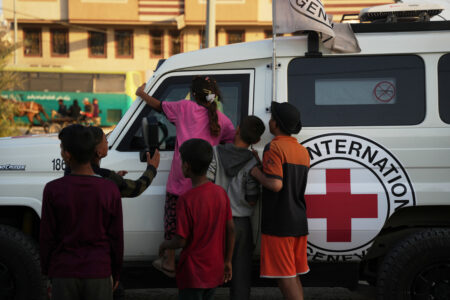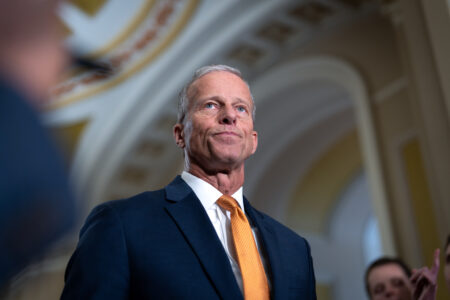SAI.Tech shows Marietta 90-day progress
- Tao Wu, director of the SAI US R and D Center and OCEC Computer Heat Recycling Technology Development Center, discusses the center’s goals and project plans with a group at the newly powered-up site on Gravel Bank Road. (Photo by Clara Noelle)
- Part of the group from Wednesday’s event wait for the start of a tour of the center’s new equipment and greenhouse project. (Photo by Clara Noelle)

Tao Wu, director of the SAI US R and D Center and OCEC Computer Heat Recycling Technology Development Center, discusses the center’s goals and project plans with a group at the newly powered-up site on Gravel Bank Road. (Photo by Clara Noelle)
MARIETTA — Just a little more than 90 days ago, when SAI.Tech introduced itself to Marietta, the site the technology company had leased on Gravel Bank Road was a fairly flat, empty piece of land near an electric substation.
On Wednesday, the SAI management team returned to show Marietta and Washington County what it has been able to do in that period of time. The site is now the start of the Computer Heat Recycling Technology Development Center, with a long stretch of power lines, a thick concrete pad that holds six giant operating cabinets and a greenhouse with adjustable heat controls. Some at the site estimated the structure to be about 190 feet long.
Or, more to the point: “huge.”
The greenhouse doesn’t contain growing plants quite yet, but guests on Wednesday received small bags of locally grown fruits and vegetables as a reminder that the time is coming. It is the first project on the computer heat recycling center’s list.
Center Director Tao Wu told the group that in speaking with local residents, he learned about Harvest of Hope and its efforts to provide needed food supplies in the community. Wu hopes to work with Harvest of Hope so that they can continue to supply fresh vegetables even in the winter.

Part of the group from Wednesday’s event wait for the start of a tour of the center’s new equipment and greenhouse project. (Photo by Clara Noelle)
A second visit in the community brought Fort Frye High School to his attention and its course where students grow vegetables and present them to the school. Wu’s second project on the list may be to work with the school and build a course of study that introduces mechanical, electronic and heat application technology.
Someday, there may be some big fish tanks, so that an area fishery doesn’t have to shut down in September because of cooling water temperatures. Heated swimming pools are another application Wu envisions.
Wu’s general goals for the center are ones he can easily list, as well.
The first beneficiaries should be the nearby, local community.
The center for computer heat recycling technology could and should be the first of its kind in the world. Getting to the fastest solutions will be part of that.
The center will be a key contributor in the world’s carbon-neutral efforts. For one thing, the center can serve as the site for demonstrations of various projects and advances in that field.
Arthur Lee, the CEO and founder of SAI, and several other speakers Wednesday made reference to the recent surge in the use of artificial intelligence and its many applications, including creative tools such as ChatGPT. They all referred to the likelihood that technology’s computational needs may double or even triple in the next few years. In that scenario, advances in computer heat recycling become even more vital in benefiting local people and society in general, lowering some technology costs and aiding carbon-neutral progress.
Haotian Li, the chief technical officer of Redesign Science, spoke Wednesday about the fact that his company is deeply involved in computer design that plays a role in cancer therapeutics.
“We’re very happy to go into collaboration with SAI,” he said.
Wu wanted to remind those attending that community members have played a key role in the center’s progress so far, and continuing support is vital for continuing success. The center is a 501(c)3 entity, as is the center’s research and study partner, the Organization of Clean Energy and Climate, OCEC.
“We welcome donations. We have sponsorships and membership fees. We will look at state and federal funding, and revenue from onsite collaboration projects. Anyone who wants to help, please do. We need help,” Wu said.
When the SAI group had its ribbon cutting at the Gravel Bank Road site in early May, networking with the county’s agricultural extension agent was on its list of goals. Marcus McCartney, the agriculture and natural resources educator for The Ohio State University Extension, was one of Wednesday’s speakers. Teaching; service on the local, state and national level; and research are the extension service’s three jobs, he said. Agriculture today is using technology extensively, and heat recapture research and development fits beautifully.
“If you’ve never seen a dairy farm use robotics to milk its cows, you’re missing something amazing,” McCartney said.
He hopes to be able to bring Ohio State’s resources and expertise down to the county level, he said.
McCartney is now one of the Computer Heat Recycle Center’s local advisory committee members, along with Jesse Roush, George Banzinger and Mark Edgell.
Roush, the executive director of the Southeastern Ohio Port Authority, opened Wednesday’s event with his remarks on the merger of industrial assets and agriculture the Computer Heat Recycling Technology Development Center brings to the Marietta, Washington County and the region.
“We know industrial electricity as well as anyone in the world,” Roush told the group about southeastern Ohio. “We have a very robust electrical infrastructure, and we’ve been at this a long time. But research and development gives us the idea that we can take an energy asset that’s been in existence a long time and combine it with access to agriculture and educational institutes in a whole new way.”
He assured the group, “This is also going to spur other sorts of development.”
Nancy Taylor can be reached at ntaylor@newsandsentinel.com.








